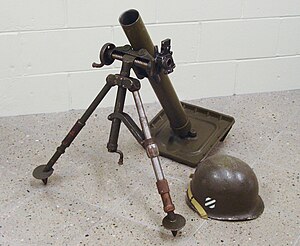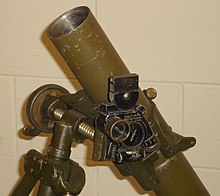Informatics Educational Institutions & Programs
Contents
| US M2 60 mm mortar | |
|---|---|
 World War II era 60 mm U.S. M2 mortar, G.I. helmet shown for scale | |
| Type | Infantry mortar |
| Place of origin | United States |
| Service history | |
| Used by | United States France Israel South Korea Republic of China China Turkey North Vietnam South Vietnam Vietnam |
| Wars | World War II Chinese Civil War First Indochina War Korean War Algerian War Portuguese Colonial War Vietnam War Soviet-Afghan War Lebanese Civil War Guatemalan Civil War |
| Production history | |
| Designer | Edgar Brandt |
| Variants | Type 31 |
| Specifications | |
| Mass | 42 lb (19 kg) |
| Barrel length | 2 ft 5 in (726 mm) |
| Crew | 5 (squad leader, gunner, assistant gunner, two ammunition carriers) |
| Shell | 3 lb (1.4 kg) |
| Caliber | 60 mm (2.36 in) |
| Elevation | +40° to +85° |
| Traverse | 7° |
| Rate of fire | 18 rounds per minute |
| Muzzle velocity | 520 ft/s (158 m/s) |
| Maximum firing range | 1.1 mi (1.8 km) |
The M2 mortar is a 60 millimeter smoothbore, muzzle-loading, high-angle-of-fire weapon used by U.S. forces in World War II, the Korean War, and the Vietnam War for light infantry support.
Description

The U.S. M2 60 mm mortar was licensed from French Brandt company to supplement the 81 mm M1 mortar and to provide a lighter-weight alternative to company-level fire support.[1] The M2 was intended to bridge the gap between the 81 mm mortar and the hand grenade. Normally employed by the weapons platoon of a U.S. infantry company, the M2 is of the usual mortar pattern of the day.[1][2] It consists of a smoothbore metal tube on a rectangular baseplate, supported by a simple bipod with the elevation and traverse mechanisms. The firing pin was fixed in the base cap of the tube, and the bomb was fired automatically when it dropped down the barrel. Though classed as a light mortar, the M2 had considerable range compared to the 50 mm and 60 mm mortars of most other nations, and its fixed-firing pin design allowed a high rate of fire by trained crews.[1]
History
During the late 1920s, the US Army began examining mortars to act as a light infantry support weapon. The War Department eventually settled on a 60 mm design from Edgar Brandt, a French ordnance engineer, and purchased a license to build the weapon. The model was standardized as the mortar, 60 mm M2. Testing took place in the late 1930s, and the first order for 1,500 M2 mortars was placed in January 1940.
The weapon was used throughout World War II by the U.S. Army and U.S. Marine Corps. It saw service again in the Korean War, and by French forces in their counterinsurgency campaigns in Indochina and Algeria.[3] It was used under designation m/952 by Portugal during the Portuguese Colonial War.[4] During the Vietnam War, the M2 was again used by the U.S. Army and marines, as well as by South Vietnamese forces. Ultimately, the M2 was replaced by the M224 in 1978.
Chinese variants
China (the Republic of China prior to 1949) also locally produced the M2 mortar, which was designated as the Type 31.[5] After the People's Republic of China was established in 1949, some Type 31s were supplied to North Korea[6] and North Vietnam.[7] It was later modified as the Type 63 and were supplied to Mujahideen rebels during Soviet-Afghan War.[8] A variant called Type 63-1 has been produced under license by the Pakistan Machine Tool Factory Limited and by the Helwan Machine Tools Company in Egypt.[9]
Operation
Each mortar shell had a screw-on cap in its base. Inside the hollow in the tail, it contained a 20-gauge M5A1 ignition cartridge. This was a paper shotgun shell filled with ballistite powder.
The mortar had a firing pin in the bottom of the tube. When the shell was dropped down the tube, the firing pin struck the ignition cartridge in the shell's tail, detonating it. When the cartridge detonated, the explosive gases exited the base of the shell through two bleed holes. This propelled the shell out of the tube in an arc. Unassisted, the mortar shell had a range of about 200 to 325 yards (183 to 297 m).
To increase the mortar's range, shells were issued with four waterproof cellophane bags of propellant, called increments, fastened to the stabilizing fins with wire clips. The ignition cartridge would ignite the propellant, increasing chamber pressure and the shell's muzzle velocity. All four increments and the ignition cartridge pushed the maximum range to about 2,000 yards (1,800 m) at 45 degrees elevation (depending on the shell's length and weight). To reduce the mortar's muzzle velocity, increment charges were removed as needed before firing. This allowed great flexibility in the angle at which shells impacted the target area, allowing the weapon to drop shells behind hills or buildings.
Ammunition


The M2 Mortar could fire several types of ammunition.
- M49A2 high explosive (HE) with point detonating fuze M52B1 [Weight: 2.73 lb (1.24 kg)]:[10] An explosive shell used against infantry and other light area targets. It has a minimum range of 200 yards (180 m) when fired without a boosting charge at a 70° angle and a maximum range of 2,017 yards (1,844 m) when fired with four boosting charges at a 45° angle.
- M49A3 high explosive cartridge (HE) with super-quick point detonating fuze M525 [Weight: 3.05 lb (1.38 kg)]: Often referred to in the field as "HE quick".
- M302 white phosphorus cartridge (WP): A "bursting smoke" shell used as a signaling, screening, smoke-producing, and casualty-producing shell.
Unlike regular smoke shells of the period, which used a "hot" chemical reaction to generate a smoke cloud, the white phosphorus shell detonates to expose its filler to the air, causing it to spontaneously ignite and generate a thick cloud of white or grey smoke. It also sets combustible materials in its radius of effect on fire, causing secondary smoke sources. If personnel are hit by burning white phosphorus, the fragments will continue to burn inside the wound. They need to be evacuated to a hospital to have the fragments removed under special conditions. - M83 illuminating cartridge (ILL): A pyrotechnic parachute flare shell used in night missions requiring illumination for assistance in observation.
- M69 training/practice cartridge (TP) [Weight: 4.43 lb (2.01 kg)]: A shell with a cast iron body, inert filler, and detachable fin assembly used to train recruits in firing the M2 mortar. The cast iron body is reusable and the fin assembly can be replaced if damaged.
- M50A3 training/practice cartridge (TP) [Weight 3.15 lb (1.43 kg)]: This practice shell is ballistically matched to the M49A4 HE shell, making it easier for training. They are the same size and weight, only differing in that the M50A3 is inert and emits a puff of white smoke on impact.
Users
 Albania[8]
Albania[8] Austria[11]
Austria[11] Australia[12]
Australia[12] Bangladesh: Type 63[13]
Bangladesh: Type 63[13] Republic of China[11]
Republic of China[11] China: Type 31, Type 63 and Type 63-1
China: Type 31, Type 63 and Type 63-1 Denmark: designated m/51[14]
Denmark: designated m/51[14] Egypt: Type 63-1 produced under license.[9]
Egypt: Type 63-1 produced under license.[9] Ethiopian Empire: used by the Kagnew Battalion[15]
Ethiopian Empire: used by the Kagnew Battalion[15] France[3]
France[3] Greece[14]
Greece[14] Guatemala[11]
Guatemala[11] Haiti[11]
Haiti[11] Indonesia[11]
Indonesia[11] Iraq: Type 63[16]
Iraq: Type 63[16] Japan[17]
Japan[17] North Korea: Type 31[6]
North Korea: Type 31[6] South Korea: The Armed Forces was equipped with 579 M2/M19s before the Korean War, and 2,263 were in service with the Army by the end of the war. Began replacing with KM19 in 1970s.[18]
South Korea: The Armed Forces was equipped with 579 M2/M19s before the Korean War, and 2,263 were in service with the Army by the end of the war. Began replacing with KM19 in 1970s.[18] Lebanon
Lebanon Mexico[11]
Mexico[11] Morocco[11]
Morocco[11] Pakistan: Type 63-1 produced under license.[9]
Pakistan: Type 63-1 produced under license.[9] Portugal[14]
Portugal[14] Turkey[14]
Turkey[14] Thailand[citation needed]
Thailand[citation needed] United States
United States South Vietnam[19]
South Vietnam[19] North Vietnam Type 31
North Vietnam Type 31 Republic of South Vietnam
Republic of South Vietnam Vietnam: M2, Type 31 and Type 63[7]
Vietnam: M2, Type 31 and Type 63[7]
See also
- List of U.S. Army weapons by supply catalog designation
- M1 mortar
- M2 4.2-inch mortar - A 107 mm infantry mortar
- M224 mortar - Replacement for the M2 in US service
- CM60A1
- List of weapons of the Lebanese Civil War
References
- ^ a b c Norris, John and Calow, Robert, Infantry Mortars of World War II, Osprey Publishing (2002), ISBN 1-84176-414-0, ISBN 978-1-84176-414-6, p. 15
- ^ U.S. Army M2 60 mm Mortar
- ^ a b Huon, Jean (March 1992). "L'armement français en A.F.N." Gazette des Armes (in French). No. 220. pp. 12–16.
- ^ Abbott, Peter; Rodrigues, Manuel (1998). Modern African Wars 2: Angola and Mozambique 1961-74. Osprey Publishing. p. 18.
- ^ "60 mm Type 31 and variants". Jane's Infantry Weapons 1992-1993. 1992. p. 1394.
- ^ a b US Department of Defense. "60mm Type-31 Mortar". North Korea Country Handbook 1997, Appendix A: Equipment Recognition (PDF). p. A-90.
- ^ a b Rottman, Gordon L. (10 Feb 2009). North Vietnamese Army Soldier 1958–75. Warrior 135. Osprey Publishing. p. 32. ISBN 9781846033711.
- ^ a b "60 mm Type 63 mortar". Jane's Infantry Weapons 1992-1993. 1992. p. 1392.
- ^ a b c "NORINCO 60 mm Type 63-1 mortar". Jane's Infantry Weapons 2002-2003. 2002. pp. 1306–1307.
- ^ FT60-D-2 (Abridged) "Firing Tables for Mortar, 60-mm, M2" - Firing Shell, H.E., M49A2 WITH Fuze, P.D., M52B1 (Plastic) - Cartridge, Ignition, M5A1 - Weight of Fuzed Projectile 2.73 lb. [2 lbs., 12 oz.]
- ^ a b c d e f g "60mm M2 mortar". Jane's Infantry Weapons 2001-2002. 2002. pp. 5338–5339.
- ^ "Mortar - 60 mm" (PDF). defence.gov.au. Defence unexploded ordnance website: ordnance information sheet. March 2015.
- ^ "TENDER NOTICE P.4 SEC" (PDF). dgdp.gov.bd. Directorate General of Defence Purchase. Retrieved March 13, 2021.
- ^ a b c d Wiener, Friedrich (1987). The armies of the NATO nations: Organization, concept of war, weapons and equipment. Truppendienst Handbooks Volume 3. Vienna: Herold Publishers. p. 462.
- ^ "Ethiopians in the Korean War: WWII gear used". wwiiafterwwii.wordpress.com. August 18, 2016.[self-published source]
- ^ Iraqi army equipment 1930-2017. Vol. 2. p. 114.
- ^ Kenji Jyoshima; Yusuke Tsuge (October 2007). 陸自車両50年史 (50 Years of JGSDF's Vehicles) (in Japanese). Tokyo, Japan: Argonauts Publications. p. 126.
- ^ Bak, Dongchan (March 2021). Korean War : Weapons of the United Nations (PDF) (in Korean). Republic of Korea: Ministry of Defense Institute for Military History. pp. 82–84. ISBN 979-11-5598-079-8. Archived from the original (PDF) on 2022-09-20. Retrieved 2022-07-07.
- ^ Rottman, Gordon L. (2010). Army of the Republic of Vietnam 1955–75. Men at Arms 458. Osprey Publishing. p. 9. ISBN 9781849081818.
- Hogg, Ian (2000). Twentieth-Century Artillery. Friedman/Fairfax Publishers. ISBN 1-58663-299-X
- Norris, John and Calow, Robert, Infantry Mortars of World War II, Osprey Publishing (2002), ISBN 978-1-84176-414-6
External links
- Cover photo of M2 60mm mortar Archived 2011-05-01 at the Wayback Machine May 1941 Popular Science

















